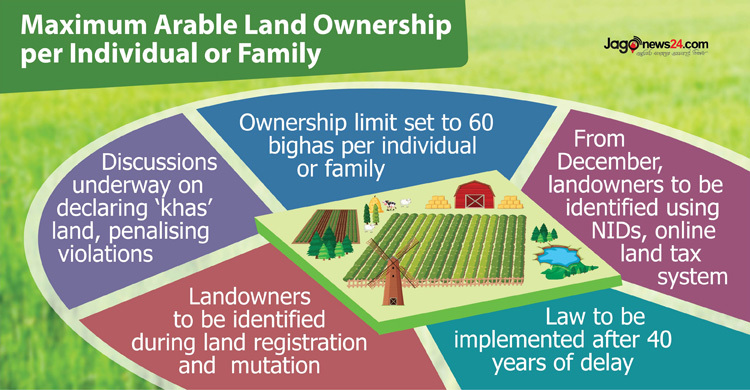Above 60 bighas arable landowners in govt's crosshairs

Starting this December, the government will begin identifying individuals and families who own more than 60 bighas of arable land, marking the first-ever enforcement of a long-standing provision in the Land Reform Act.
Although the law limiting land ownership to 60 bighas has been in place for over four decades, no prior administration has implemented it until now.
To initiate this process, officials from the Ministry of Land plan to use National Identity Card (NID) data through the online land development tax system, because a precise system to track land ownership by individuals or families has yet to be established.
The primary focus will be identifying landholders who exceed the legal limit, with potential future actions for land redistribution or penalties still under consideration.
Many individuals in the country are believed to possess more than 60 bighas of land, and officials anticipate possible resistance if the law is fully enforced.
For now, however, the focus remains on detection and limiting future acquisitions.
The 1984 Land Reforms Ordinance first introduced the 60-bigha limit, which was reaffirmed in last year's updated ‘Land Reforms Act, 2024’.
According to Section 4, individuals and families cannot acquire additional arable land beyond the 60-bigha limit through purchase, inheritance, donation, or other means, although exceptions apply for specific cases such as land for cooperatives, export-oriented industries, or public welfare projects, provided they have government approval.
The law mandates that any newly acquired agricultural land beyond 60 bighas will be surrendered to the government without compensation. However, inherited land over the limit may be retained up to 60 bighas, with the remainder potentially subject to government acquisition with compensation.
Implementation strategy and challenges
To streamline implementation, the Ministry of Land is considering a variety of approaches to avoid legal complications. Land Reforms Board Chairman (Secretary) Md Abdus Sabur Mandal emphasised that while the law has long been on the books, efforts are now underway to enforce it practically.
"According to the law, no one can own more than 60 bighas of agricultural land. We are actively working on implementing this provision," Mandal stated.
Additional Secretary of the Digitalisation, Knowledge Management, and Performance (DKMP) Division, Md Emdadul Haque Chowdhury, indicated that the identification process will start at the individual level using NID data and then expand to include family holdings.
Individuals holding land beyond the limit will have their holdings flagged, and additional checks will be conducted on family members' land ownership to ensure compliance.
"We will block any transactions that exceed the limit," Chowdhury explained. "When our land data bank is fully functional, it will alert us if anyone exceeds the 60-bigha limit, effectively halting further registration."
The ministry is also developing an enhanced online land tax system to provide detailed land records linked to an individual’s NID. A forthcoming update, LD Tax Version 2, will allow officials to view the total land registered under a person’s NID, supporting more accurate monitoring and enforcement.
Cross-agency collaboration and future measures
Efforts to implement the law also involve collaboration with the Anti-Corruption Commission (ACC) and local government departments to verify family connections and ownership history. Joint Secretary of the DKMP Division Md Zahid Hossain Panir highlighted that family relationship data from local government records—such as birth and death registrations—could provide further transparency in identifying land ownership by relatives and preventing the use of surrogate names.
In cases of mutation (ownership transfer), new measures may include a mandatory declaration by the landowner, certifying their total land holdings, which would be flagged for review by the ACC.
The ministry is also exploring potential requirements for property registration, enabling cross-referencing with family NID records.
Deputy Secretary of the DKMP Sub-Division, Selim Ahmed, elaborated that owners exceeding the limit could be flagged at multiple stages—registration, mutation, and tax filing—through NID verification and family connections.
"With our current data, we can identify landholders who exceed the 60-bigha threshold," Ahmed said, emphasising that tax payment records are already being integrated into the new monitoring system.
In the coming months, the Ministry of Land aims to establish a robust system for tracking agricultural land ownership across the country, setting a precedent for legal compliance and land reform.

